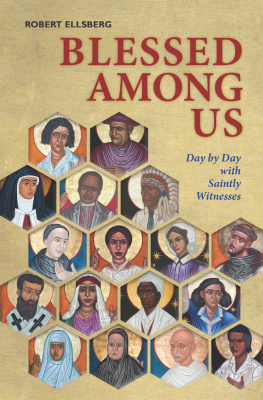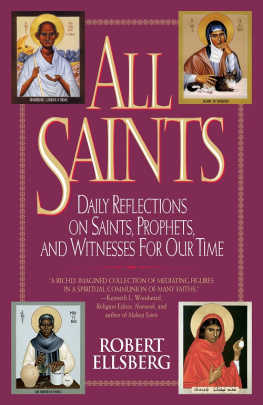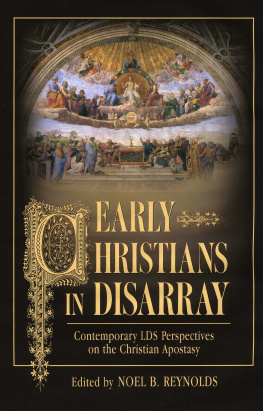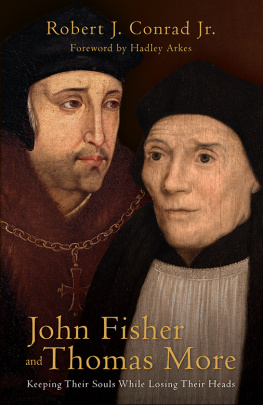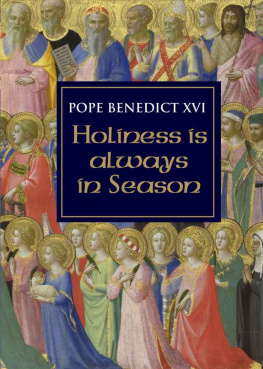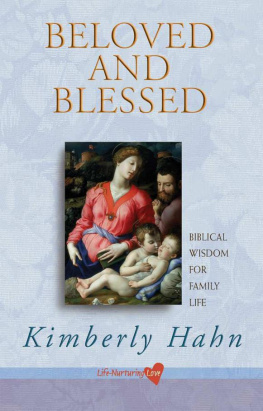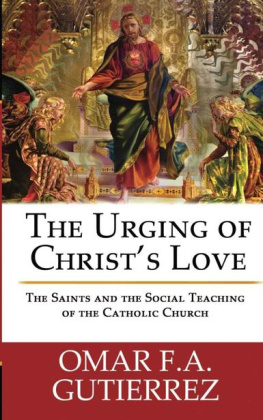Every single day I read Robert Ellsbergs concise, fascinating, and inspiring lives of the saints in my copy of Give Us This Day. And every single day I am amazed by the astounding lives that have been lived out of love for Christ. Happily, many of these wonderful stories are now gathered together in this marvelous new book, which will guide you through the year with the help of these patrons and companions.
James Martin, SJ, author of Jesus: A Pilgrimage
This delightful book reminds us how blessed we are, in every age, to have people of good faith who are called to love and serve people in need. They call us all to a greater purpose.
Kathleen Norris, author of The Cloister Walk and Acedia and Me
The diversity of these holy men and women calls out my own gifts, and their total dedication alerts me to put my yes into motion for the day. Thank you for being a companion and inspiration for my faith journey!
Carolyn Y. Woo, President and CEO of Catholic Relief Services and author of Working for a Better World
This is not only a classic collection of lives of the saints but also an introduction to many un-canonized holy lives, producing such delightful juxtapositions as St. Nicholas and Mozart, St. Mary Magdalene and Albert Luthuli, St. Monica and Helder Camara. As a reader of Give Us This Day, from which these are drawn, Ive enjoyed meeting new holy men and women and am now delighted to have them alongside traditional saints of the day. Thank you for this literary treat.
Christopher Jamison, OSB, Director of the National Office for Vocation, London, and author of Finding Sanctuary
Robert Ellsberg is way up there in my pantheon of spiritual writers. Hes especially good at connecting us with the divine spark in practitioners of every spiritual tradition. These very human stories of the holy ones among us have a special knack of enlivening my spirit.
Helen Prejean, CSJ, author of Dead Man Walking
Saints are the living Word of God, the Word made flesh, but their biographies are often too encrusted within sentimentality and piety to serve as an inspiration for us. Ellsberg gives us their essence in this treasure of a book. Nobody writes better about the lives of the saints than Robert Ellsberg!
Ronald Rolheiser, OMI, President of the Oblate School of Theology and author of The Holy Longing and Sacred Fire
It is a challenge to provide inspiration in a brief and daily format. Robert Ellsbergs writing does so, exposing us to numerous little-known saints, with a generous sprinkling of contemporary saintly lives, his signature contribution. This book is a keeper.
Pat Farrell, OSF, Past President of the Leadership Conference of Women Religious
A Give Us This Day Book
published by Liturgical Press
Cover design by Ann Blattner
About the cover: The holy people featured on the dust jacket and end sheets of this volume are details from the Dancing Saints icon at Saint Gregory of Nyssa Episcopal Church, San Francisco, California. The Dancing Saints is a monumental icon created by iconographer Mark Dukes and the people of Saint Gregorys. Visit saintgregorys.org to learn more. Images used by permission.
2016 by Order of Saint Benedict, Collegeville, Minnesota. All rights reserved. No part of this book may be reproduced in any form, by print, microfilm, microfiche, mechanical recording, photocopying, translation, or by any other means, known or yet unknown, for any purpose except brief quotations in reviews, without the previous written permission of Liturgical Press, Saint Johns Abbey, PO Box 7500, Collegeville, Minnesota 56321-7500. Printed in the United States of America.
The Library of Congress has cataloged the printed edition as follows:
Library of Congress Cataloging-in-Publication Data
Names: Ellsberg, Robert, 1955, author.
Title: Blessed among us / Robert Ellsberg.
Description: Collegeville, Minnesota : Liturgical Press, 2016.
Identifiers: LCCN 2016007536 (print) | LCCN 2016014574 (ebook) | ISBN 9780814647219 | ISBN 9780814647455
Subjects: LCSH: Christian saintsBiography. | Christian biography. | Devotional calendars.
Classification: LCC BR1710 .E45 2016 (print) | LCC BR1710 (ebook) | DDC 270.092/2dc23
LC record available at http://lccn.loc.gov/2016007536
To Mary Stommes,
Sue Kuefler,
and Peter Dwyer.
It all happened while we sat there talking, and it is still going on.
Dorothy Day

INTRODUCTION
From the early days of Christianity it was understood that a Christian was someone who strived to imitate or follow Christ. This was not simply a matter of believing in certain doctrines but of allowing ones identity and way of life to be shaped by Jesus and his example of self-giving love. One was not born this way; in some way or another it involved a process of conversion, of putting off the old person and putting on Christ, as St. Paul put it. All Christians were called to this conversionthe work of a lifetime, even if it might begin, as it did for Paul, with a dramatic turning point.
As Jesus foretold of his disciples, those who followed this path were liable to share his own fate: misunderstanding, persecution, and even death. For that reason, in the early Church, martyrdom became a particular proof of authentic discipleship. Beginning with the first martyr, St. Stephen, such witnesses (the literal meaning of martyr) were seen as reenacting the passion of Christ. It was said of St. Polycarp, an early bishop who was martyred in 155, that his very death was conformable to the gospel. The early Christians venerated the stories of such witnesses, preserving their relics and memorializing the anniversaries of their deathstheir dies natalis, or birth to eternal life. This was the origin of the cult of saints.
As the era of persecution waned, it became clear that there were other ways, no less heroic, of bearing witness to Christthrough ascetical lives of prayer, service to the Church, or the practice of charity. New models of holiness emerged in the form of desert monastics, missionaries, bishops, and other teachers of the Christian faith. Regardless of the form, there were certain individuals who set a standard for Christian practice; their witness inspired the faith of their contemporaries, even evoking a sense of wonder. Such individuals seemed a living link with the Gospel itself. As Alban Butler, one of the great English compilers of saints lives, put it, they were the Gospel clothed, as it were, in a body.
In the early days, saints were recognized more or less by public acclamation. Their memory was preserved through the ongoing prayers of the faithful. To the extent that such devotion was reinforced by reports of miracles, attention often shifted from the actual lives of the saints to their role as heavenly patrons. The Golden Legend, a collection of saints lives by Jacobus de Voragine (d. 1298), was one of the most popular books of the Middle Ages. It emphasized the fabulous and miraculous deeds of the saintshelping to boost the popularity of such figures as St. George (who battled a dragon) or St. Christopher (who carried the Christ child on his back) over much better-attested, if more prosaic, figures as St. Augustine or St. Ambrose.
Over time, the Vatican assumed responsibility for the naming of saints, introducing the much more complicated process of canonization. Among the minimal criteria was the reasonable confidence that such a person in fact existed. But there were many other considerations and factors to be examinedso many that the process could take centuries. In recent years Pope John Paul II streamlined the procedure considerably. Moved by a belief that the Church needed more examples of holiness from our own time and from many diverse cultures, he beatified and canonized over a thousand men and womenfar more than in previous centuries combined.

